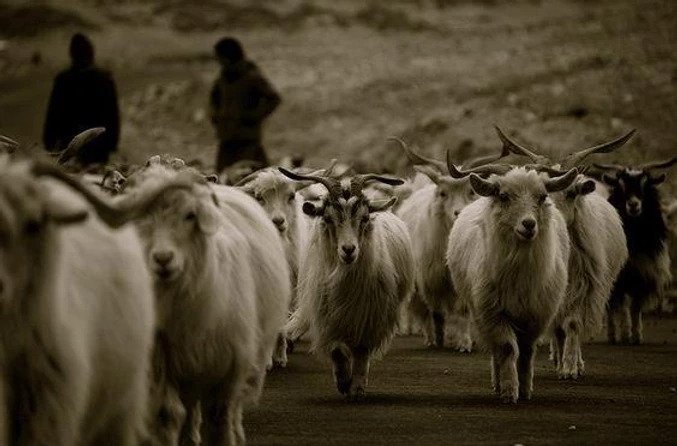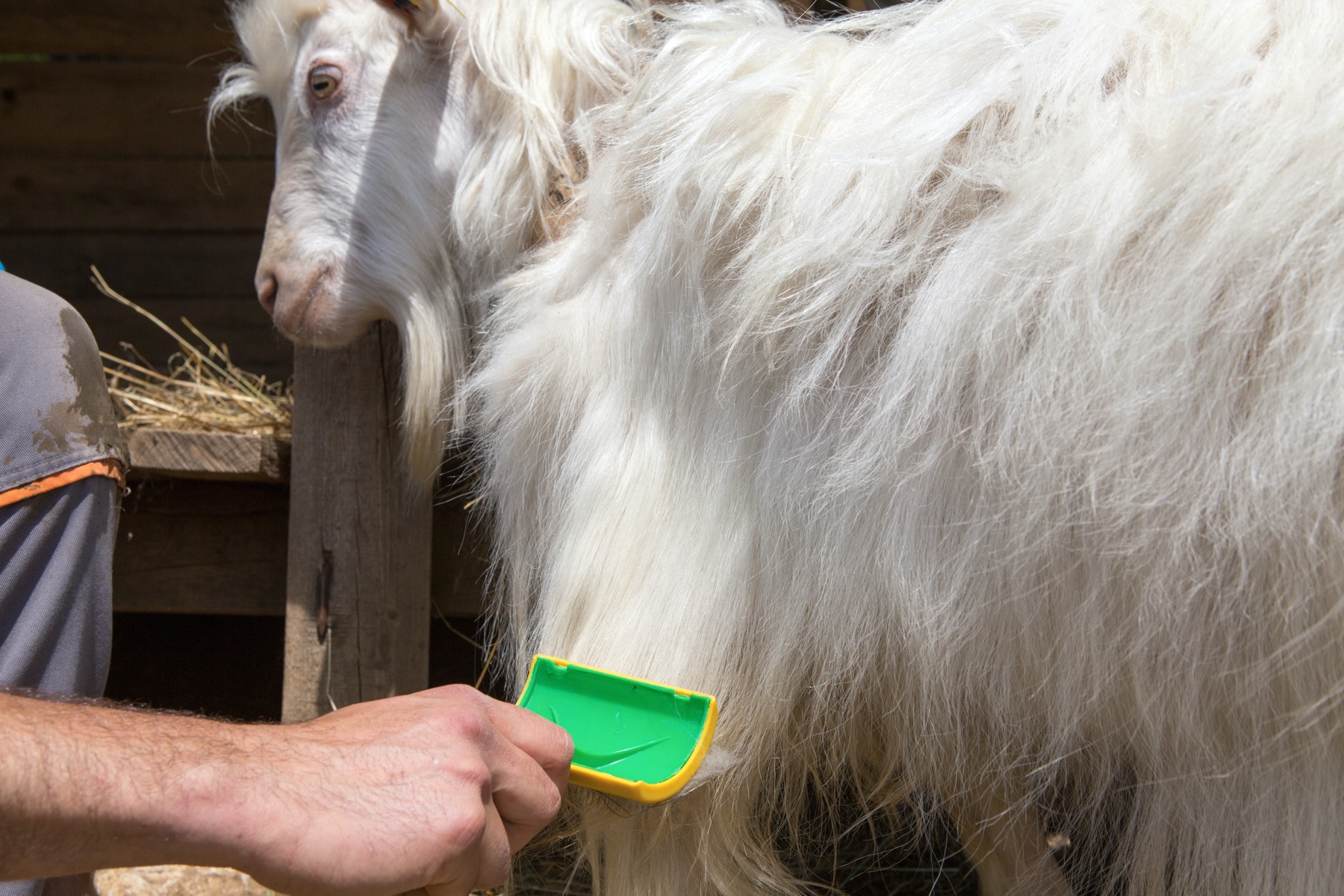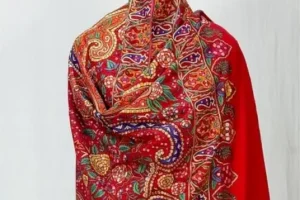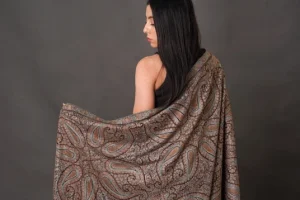Pashmina is derived from the Persian word Pamina which literally means “made of wool”. Pashmina is an Urdu word with a Parsi origin and is the name given to Changthangi goat’s fleece. Pashmina is rare and desired around the world because it is found 15000 feet above sea level in Ladakh, India. Pashmina has fascinated kings, royals, and people all over the world with its magical allure and traditional elegance. Perhaps, it was for this reason that we chose to demonstrate the exquisiteness and regal demeanour of this centuries-old art to the rest of the world.
Pashmina’s Royal Admirers
Pashmina has had patronage from all over the world for a long time. There was a period when royal patronage was given to this art form. Pashmina was known to kings, queens, royal families, and nobles all over the world. They had quite a collection of shawls and scarves.
Pashmina was discovered in the 16th century, when the birthplace of Pashmina, Kashmir, was under the Mughal rule. And even the mere sight of it swooned the Mughal kings of the time. Later, the aesthetics of this art spread much further, and Napoleon Bonaparte gave a Pashmina shawl to his wife, Josephine. During that time, she is thought to have owned a few hundred shawls. Iranian rulers wore and gave Pashminas as part of their political activities. Hand-embroidered Pashmina shawls and fabric were used to decorate Maharaja Ranjit’s court in India.
Pashmina is also regarded as the king of all fabrics, making it classic and timeless.
Changthang’s Nomadic Land
A glamorous Pashmina shawl’s dramatic elegance and ornamental allure had a humble beginning.
Changthang is the land of the nomads, situated about 14600 metres above sea level east of Leh. The area is undeveloped and unusual. Once you cross Changthang peak, it appears that the city’s noise and grit fade away. Extreme climate, high altitude, and remoteness can be contributing factors. Since these characteristics made Changthang unsuitable for agriculture, local nomads began raising Changthangi goats. These conditions are ideal for goats. These goats produce fine but strong undercoats, which is the same fleece that is used to make Pashmina shawls in Kashmir.
Let us take you on a journey through this incredible art, beginning in Ladakh and continuing through the narrow alleys of Kashmir to luxury stores all over the world.
The Pashmina Journey: A Step-by-Step Guide to Pashmina Production
1. Goat Pashmina
Changthangi goats are strong, active, and well-acclimatized animals. They spend the majority of their time growing up in a free large-range grazing environment. They can only be found in high altitudes in Ladakh, where the temperature drops to around – 25 degrees Celsius and develop a thick, warm undercoat, which is the source of Kashmir Pashmina fur. Changthangi goats have a lower reproductive rate and can only have one child per year. It is, however, extremely expensive due to its high demand.

These goats’ wool is only harvested once a year, typically in June or July. Combing or shearing is the most popular method for harvesting hair. Pashmina production is largely determined by the size of the goats, which can vary from 70 to 500 grammes per goat. The wool is used to make Kashmir’s popular Pashmina Shawls, which are then sold for a high price all over the world. These Kashmiri goats can be found in the Ladakh region of Northern India, China, and Mongolia, among other places.
2. Combing
The wool is picked by hand by combing out the under fleece from the Goat’s Coat (rather than shearing, as is the case with lamb’s wool). Professionals never bother the goat when combing it; instead, they wait until the Pashmina is completely loose and comes off easily in many places. It is not necessary to comb the goat daily. It’s crucial to comb off the fleece at the right time. They wait for the complete shedding of the Pashmina to conserve even the micro-samples and hold zip-lock bags with each goat’s name at the barn.
Until they begin combing, they carefully observe the goat(s) to see if they are combing on their own with whatever is available. Goats can be seen running through the brush and rubbing their bodies against the fence multiple times a day to shed their fleeces. Combing practitioners comb the prime areas first, then move on to the head, neck, chest, and britches, where the fibre is shorter and coarser, to filter the cream. Then they get a grocery paper with the name of the goat’s body area they’ve combed on it, and they keep the fibre within the belonging area.
What are the most important tools and accessories for combing?
Experts need the following equipment to perform proper combing and extract the full amount of fibre.
- a shopping bag made of paper (has to be labelled with the name and date for each goat)
- A brush with natural bristles
- A large pin brush is needed
- A superb Slicker (similar to a hand corner)
- A metal comb with several teeth
What is the procedure for combing?

Professionals use a bristle brush to clean off any surface debris before beginning the combing process. They begin by brushing against the guard hair gran and then with the natural hair lay. After that, they begin brushing along the backbone with the big pin brush. They brush in 6 strips down over the goat’s ribs to the belly. This procedure aids in the loosening of Pashmina fibres. Finally, they use a slicker and lifting fibre that starts at the belly button and combs down into small pieces.
3. Sorting
Pashmina has a multi-staged sorting process. It is sorted in the first stage to remove any low-grade pasmina as well as any synthetic contaminants. After that, the stock is baled and stored. The skilled labour, using their years of experience in the production of pashmina goods, sort the fine pashmina from the mixture of other substances such as Guard Hair.
While they carefully use the sorting technique from the beginning of the process, it is overdone to ensure Pashmina’s consistency. After removing the low-grade waste, the remaining sorting ensures that the fibre is broken down into the colours white, light grey, cream, and camel.
4. Pashmina of exceptional quality
Fine pashmina refers to a special fibre obtained from goats who only grow pashmina once a year. A single piece of Pashmina shawl takes a lot of time and effort to make as it involves lots of processes like sorting, spinning, weaving, and dying, and it’s typically done by hand.
To get the right pashmina, you’ll need to put in a lot of work and use a variety of quality check measurements. 12-15 microns is the best micron range for pashminas.
5. Spinning of Pashmina Thread on Charkha
The spinning of pashmina yarn is done on traditional charkas and is mostly done by the ladies in the remote areas of Kashmir, India. The yarn can be spun to a maximum of 108 counts to 110 counts on Charkas.
6. Weaving of Shawl/Fabrics
After the spinning of yarn, finally comes the weaving of shawls which is done on handlooms, and since the yarn is very thin and soft it requires starch to increase the strength of thread so that it can be easily woven on looms.
8. Laundry
Following the weaving process, the fabric is washed to remove grease, dust, and other types of impurities. During this process, skilled workers cross-check the entire fabric to ensure that it is free of any toxic substances that could impact the consistency of the final pashmina shawl. That is the path that leads to 100 percent pure pashmina.
9. Dying
The dying process is often meticulously carried out by skilled individuals who have been practicing this art for decades. Since it is a delicate fabric, its beauty and attractiveness are heavily reliant on the dying process. The entire process necessitates a great deal of patience and expertise. Usually, natural dyes are used to dye the scarves/shawls to ensure the finished product’s consistency and elegance.
Pashmina’s Adventure.
- How did the hand-embroidered shawl come to be?
As the demand for Kani shawls grew in the 18th century, so did the complexity of the designs. It would take two weavers three years to weave an intricate Kani shawl, which would lock up a large sum of money for a long time.
To address this problem, Kani shawls were woven in panel designs. The various elements of the pattern were then stitched together to create a unified shawl.
The “rafugars” stitched the panels together with such precision that the seams were difficult to spot.
This reduced the time it took to make an intricate Kani shawl from three years to six to eight months. However, the number of looms used and the number of Kani weavers employed on them increased significantly.
Compared to Kani shawls with a similar body of work, an embroidered shawl took a quarter of the time to complete. As a result, it was much less expensive than Kani shawls. The embroidered shawls were impressive in terms of appearance. Since embroidered shawls took less time to produce than Kani shawls, they cost much less.
With the trend of more intricate designs for Kani shawls, resulting in higher costs, embroidered shawls, which have lower prices, began to gain popularity. These embroidered shawls were first made in the 18th century and were known as “Amlikar Shawls.”
The pattern to be embroidered on the shawls is traced out with perforated lines for embroidering. Via the perforations, a fine powder of a contrasting colour is imprinted onto the shawl. The outlines would be clear on the shawl until the tracing was removed, ready for the embroiderer to begin work.
Embroidery gaining popularity.
The embroidery reached its peak in the mid-nineteenth century. It was at this time that embroiderers devised a new technique for creating shawls with two different colours on each hand. These were known as “do-runga” shawls, which meant “two-coloured.”
On the backside of the embroidered shawl, the technique entailed imitating the Kani weave. To imitate the Kani weave, a different coloured thread was interlaced through the fabric along with the motif.
Although the do runga shawls are still produced, the do runga embroideries made with pashmina yarn have vanished from Kashmir since the mid-nineteenth century.
- What is the pashmina hand embroiderers’ history?
Pashmina hand embroiderers come from generations of families who have studied, taught, and passed on the craft. These professional artisans have spent over a half-decade painstakingly designing exotic Pashminas for a single shawl. In today’s world, the most refined pieces, with embroidery noticeable on both sides, are rare. The royal families wore these double-sided or “do-rukha” shawls. These were, in reality, the ones that were given as gifts to foreign nobles and rulers.
The foreigners were so taken aback by these magnificent shawls that they were quickly won over. Everyone’s desire was piqued by the exquisite handicraft.
The French empress Josephine adored these beautiful shawls so much that she ordered more to give to her royal court guests.
- What were the different styles of motifs used on the pashmina shawls?
The Pashmina shawls were woven with a variety of designs and patterns. The following are the most well-known.
- Buti: This is a tiny one-of-a-kind flower style.
- Buta: A multi-floral motif that is much larger than a buti.
- Khat-rast: This shawl’s pattern is striped and runs the length of the shawl. The buti is often incorporated into the stripes.
- Badam/ Ambi/ Kairi: This pattern is known as “Paisley” all over the world. In the majority of the shawls, it has become the dominant motif.
- Lahariya: This zig-zag motif is commonly used to represent water.
- Shikargah: It is a word that means “hunting.” This shawl motif portrays jungle scenes with a large number of animal and human figures.
- Hashia: 4-sided 1 inch border design that encloses the main motifs such as buta, paisley, chinar and so on.
- Neem Daur: 4-sided 2 inches border design that encloses the main motifs such as buta, paisley, chinar and so on.
- Daur Dar: 4-sided 2.5-3 inches border design that encloses the main motifs such as buta, paisley, chinar and so on.
- Kalan Daur: 4-sided 4-5 inches border design that encloses the main motifs such as buta, paisley, chinar and so on.
- Jaal Design: It is an all-over embroidery with the motifs of chinars, paisleys, pattis, etc.
- What dyes are used to colour pashmina shawls?
Organic dyestuffs were used for a wide variety of colours from the 17th century to the mid-19th century. To create a large range of 64 colours, professional dyers will only need five to six different substances.
For shades of blue, violet, dull red, and yellow, organic dyestuffs included indigo, lac, kermes, logwood, safflower, and saffron. The broad colour palette is thought to have been accomplished by changing the dye’s intensity and mixing it with other dyes.








thanks for sharing the great post.
Wow,
Great information 👍
Wow
Thank you!! 😀
This content is fantastic. Thanks for sharing!